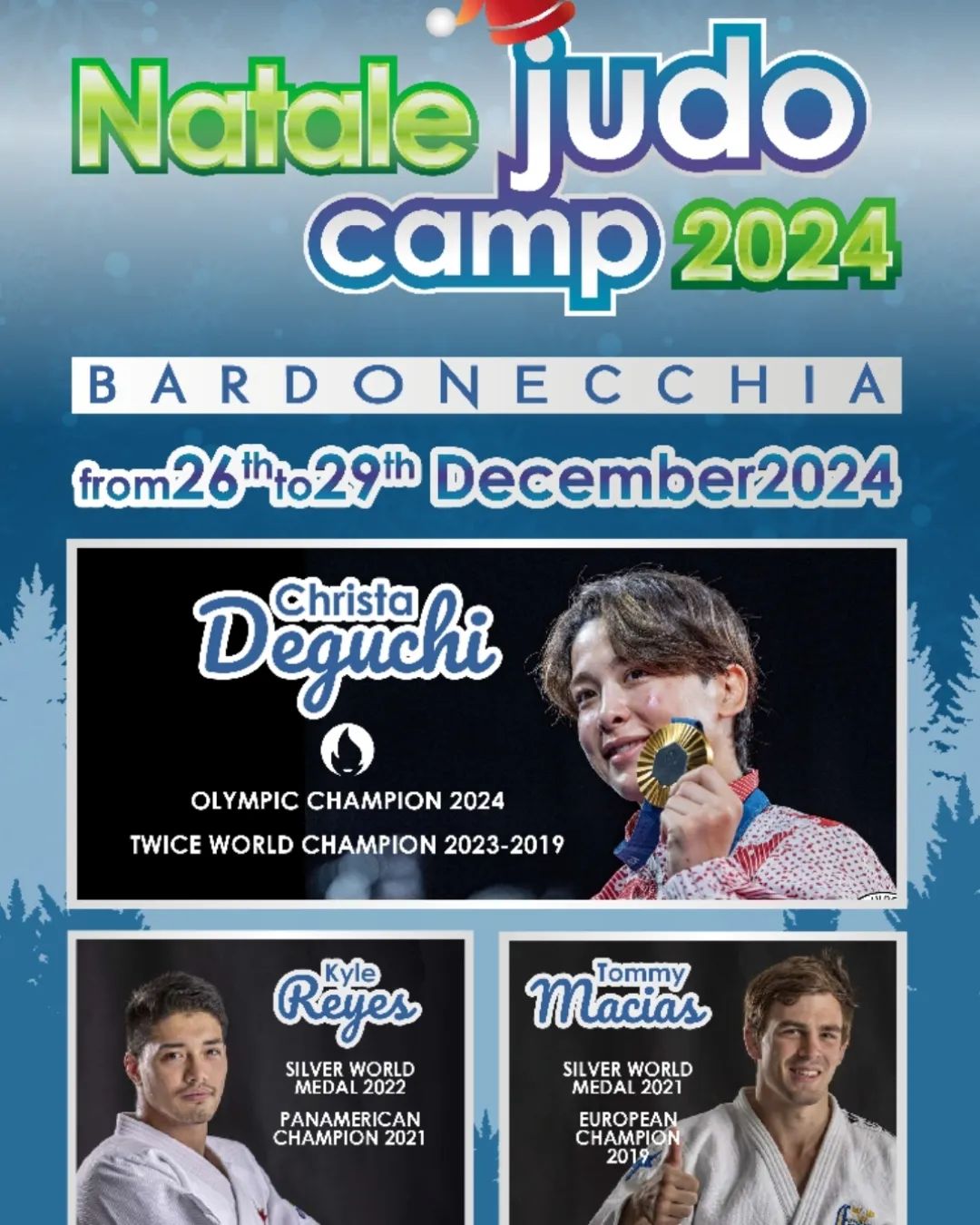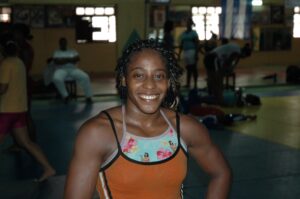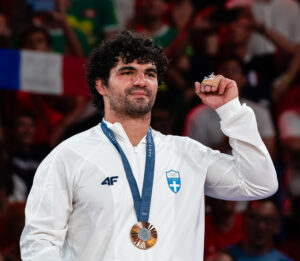Born on 2 May 1966 in Este (Italy), Raffaele Toniolo has been the master of ceremonies of a Christmas course of growing renown since 1996. Since 2012, it has been held on the heights of the Bardonecchia ski resort, just across the Alps from the Fréjus tunnel. It is the winter counterpart to another course, this one in the summer, which takes the club’s young judokas to the seaside. With his partner Monica Barbieri and his brothers Pierangelo and Massimo, who we went to see at work in their Turin stronghold of the Akiyama Settimo (video below), Raffaele Toniolo is at the helm of this 26 to 29 December event, which brings together a thousand judokas from a dozen or so countries every year. Over the years, we’ve seen Germany’s Ole Bischof, Serbia’s Nemanja Majdov, Slovenia’s Urska Zolnir and Tina Trstenjak, Georgia’s Varlam Liparteliani, Hungary’s Krisztián Tóth and Kosovo’s Majlinda Kelmendi demonstrate the importance of hand placement in combat strategy; Korea’s Jeon Ki-young reveals the secret of his famous reverse seoi – which he denies inventing in an interview, preferring to leave this paternity to one of his… students -, or the Czech Lukas Krpalek’s chest-pounding display of boa constrictor flipping, which has been imitated a thousand times but never equalled; Canadian Christa Deguchi, Japan’s Soichi Hachimoto and the local favourites, Italians Fabio Basile and Manuel Lombardo, embody the importance of body shape in the execution of a technique… We, in turn, have seen and tried all this and much more, in the course of the technical sessions and fights that turn the huge gymnasium into an authentic sauna, but also in the discussions at the end of meals or third halves, where the realities of each person are understood and measured a little better, whether it’s this octogenarian club coach with a million teaching anecdotes or this apprentice champion full of confidence in his field of expertise but sometimes a white belt and eager to learn about other areas of life.
For all these reasons, we wanted to give the floor to Raffaele Toniolo, in his capacity as kingpin of this pure moment of mutual help and prosperity, but also as coach of the Italian men’s team and, incidentally, proud father of two daughters who repay him well, the latest being the national holder in the U57kg category at the Paris Olympics. – JudoAKD#028.
A French version of this interview is available here.
There’s a question I’ve been wanting to ask you for a long time. How do you feel every year on the evening of 29 December, when almost everyone has left Bardonecchia? Is it a mixture of loneliness, pride and tiredness? Do you have a routine, such as dinner with friends and family? How are the next few days going?
That’s a good question… First of all, one thing’s for sure: on the evening of 29 December, every year, I’m really rinsed out. After dismantling the carpet and saying goodbye to everyone, I realize that the edition is over. Some years I’m free immediately afterwards and Monica and I head straight home. Other years, I stay a few extra days with a few guests to visit the city. In those cases, I don’t come home until afterwards. And then, once I’ve settled down, it’s total rest. After four days full time on the tatami, I need it.
How did this adventure begin and how did the choice of that week, between Christmas and New Year’s Day, come about?
It all started in 1996. At the end of the eighties and the beginning of the nineties, my brothers Massimo, Pierangelo and I used to train in August at the famous Bertinoro course organized by Alfredo and Beppe Vismara. At the time, this course was the best in Italy, and the Vismara brothers usually invited athletes or coaches to give technical lessons and show off their best skills. That’s how we were able to hear contributions from Montreal Olympic medallist Slavko Obadov from Yugoslavia, Belgian Olympic champion Robert Van de Walle and his compatriot Jean-Marie Dedecker, coach of the great generation of Ingrid Berghmans, Ulla Werbrouck and Gella Vandecaveye. My brother Pierangelo had the idea of organizing a course and we chose the Christmas period because in Italy, nobody organized a course at that time. Meanwhile, at Akiyama, we had a lot of very good cadets and juniors and, for the first edition, we had around 80 people. It was in Entracque, a tiny village in the mountains near Cuneo.
When did you feel that this course was starting to grow?
Right from the second edition. There was only one hotel in Entracque, so it wasn’t possible to increase the number of participants. For this reason, and also to offer better opportunities for those participants who wanted to take advantage of the nearby ski facilities, we decided to move to Gressoney, one of Italy’s most famous ski resorts near Monte Rosa. At first, we stayed in a big mountain house called Gino Pistoni House. After five editions, we extended our accommodation to another house run by a nun. We stayed there until 2011 because, despite the two houses and a few flats to rent, we could only accommodate ‘just’ 600 people and, every year, many judokas had to find accommodation outside the camp. That’s why in 2012 we decided to move to Bardonecchia, which we felt was the best solution for increasing the number of people and ensuring that as many participants as possible were housed together in the same building.
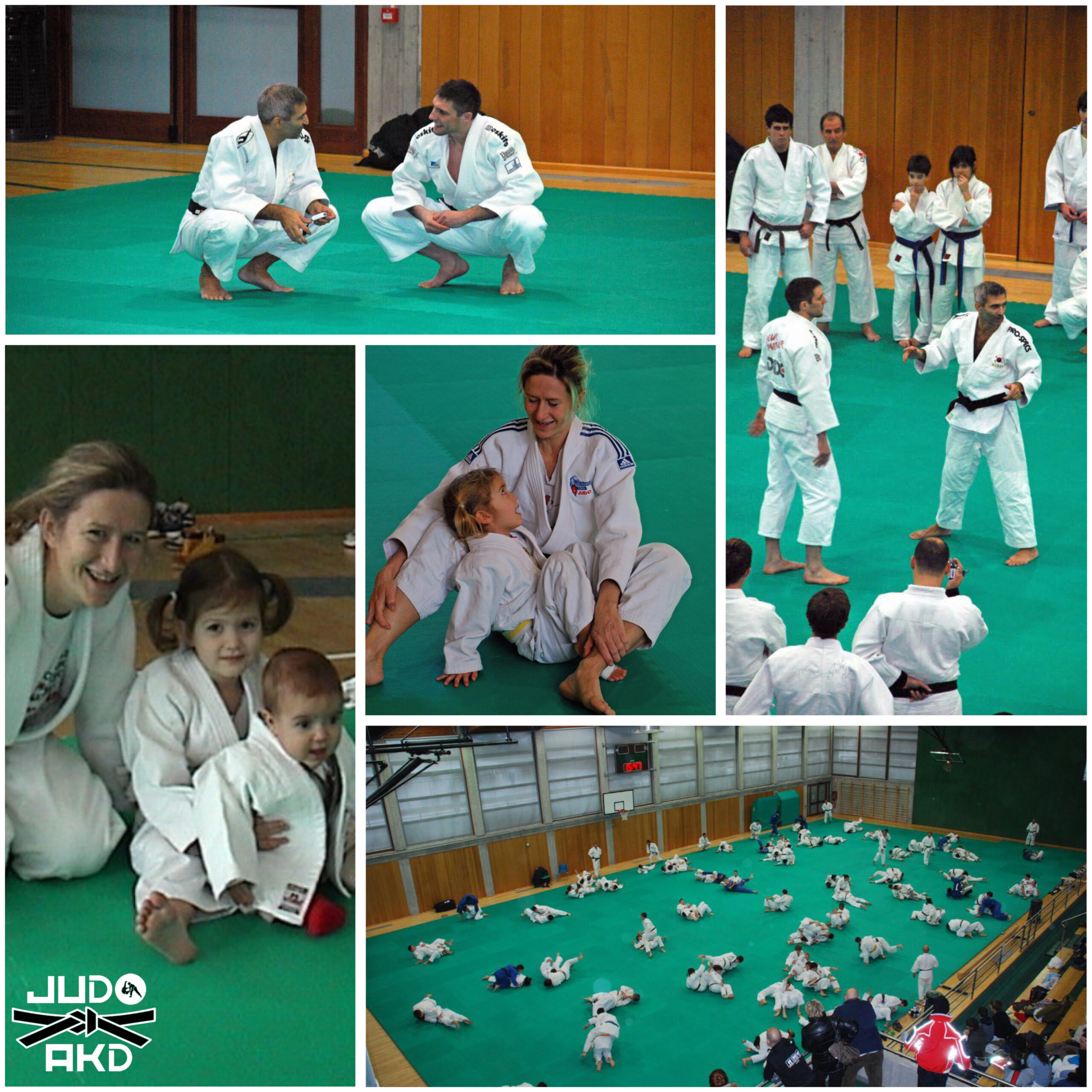
How did you decide to organise the course in the current format with two or three headliners?
We started with just one coach, then after a few editions, in 2002, we added a guest. From 2005 we invited two coaches to run the course. Then, as the number of participants increased from year to year, we gradually moved to three guest speakers, which I think is the best solution.
How do you manage to always have big names at this particular time of year?
It’s not easy. We’ve already had a lot of great champions, so it’s very difficult to find new ones every year. Sometimes we agree with someone and then we have to change because of an injury or because the IJF calendar changes and he or she can no longer come. As we approach the 28th edition of our course, we’ve had 12 Olympic champions, 8 Olympic medallists and 9 World champions as speakers. And every year we try to offer the best solution for everyone.
Who does what? How many people are at the heart of the organisation?
We divide up the tasks. Normally, Pierangelo looks after relations with the Olympic Village, which welcomes us every year, and the town of Bardonecchia. Together with Monica, they look after accreditation and room allocation. My job is to work with Monica and my two brothers to come up with the speakers for the coming years, draw up the carpet schedule and run the various sessions. Of course, we have lots of friends who help us during the course.
How many months in advance do you prepare an edition?
Normally, we start thinking about the next edition in February/March each year.
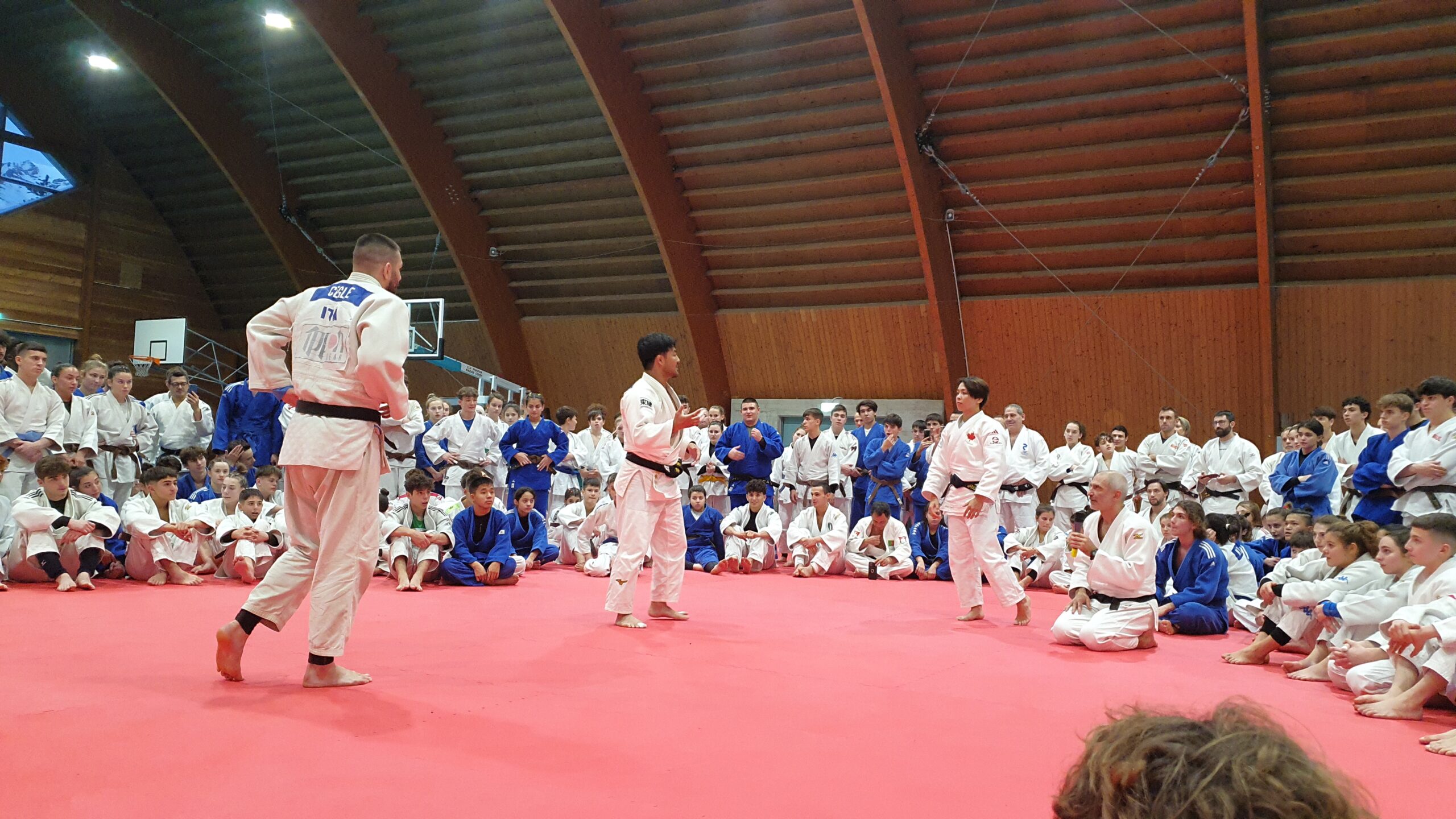
On 13 February 2024, your daughter Veronica was officially selected as a the U57kg weight class category’s member of the Italian team for the Olympic Games. It was no surprise, given her rise to prominence since her European and World double in the cadet category in 2019 and in the junior category in 2023, but I think that as a father, this is an incredible source of pride…
In fact, the whole family is proud of this result. Qualifying for the Olympics is a very important moment in the life of a judoka and of any sportsperson in general. Veronica is obviously very happy that the Italian Judo Federation has announced her selection, because it means she can prepare better for the event.
When did you and Monica start to believe that, despite her young age, your daughter could really look forward to Paris 2024?
We were convinced right from the start of the Olympic qualifying period, because we know very well what she can do. Even in difficult times, we always believed.
You are a ‘total judo family’: you, your partner Monica, your daughters Elisa and Veronica, your brothers Pierangelo and Massimo, your father too… and maybe others I don’t know yet?
Yes, we’re a judo family. Our eldest daughter Elisa is also into judo, having taken part in the EYOF (European Youth Olympic Festival) in 2017 and the cadet World championships, as well as the junior European championships in 2020. In 2023, she won bronze at the Italian U63kg category. But she also has a degree (like me) in physics and is now studying medical physics. And, indeed, it was my father who started it all.
What do you mean by that?
In 1976, my brothers Massimo, Pierangelo and I were swimming and doing other sports. Our father, who was 40 at the time, had a work colleague who stopped smoking as soon as he started judo, so he decided to take up judo… to stop smoking. He took one class and, on the second, he decided to take us to the dojo with him. And, as we were already busy all afternoon with other sports, he decided to take us to the adult class. For Massimo and me it was quite simple because we were very similar, I was 9 and he was 8, but Pierangelo was 5. Can you imagine?
Of course I can…
After a few months my father and I passed the yellow belt test and, in September, we started the season in a ‘normal’ class with children of our own age. My father, on the other hand, managed to give up smoking after his yellow belt, so he gave up practicing judo on the tatami to devote a large part of his life to building the Akiyama.
Precisely, during my report at the Akiyama Settimo, I was really impressed by the way in which everyone knows exactly what they have to do there: Massimo with the children, Pier with the budding champions, you with the national team… Elsewhere, I’ve come across many apprentice champions who don’t continue because their first teacher won’t let them cut the cord and grow up away from them. How did you manage to find this balance? I’m guessing that you too have made your share of mistakes along the way. How many times a month do you exchange information with your brothers, for example?
As far as the top judokas at Akiyama are concerned, I talk to Pierangelo every day to plan training sessions and competitions.
Sometimes, having strong family solidarity can scare others and make you an ‘island’ in the Italian judo system. How do you avoid this and build bridges? Is Bardonecchia part of this process?
For many years, Akiyama was indeed an ‘island’, not for us but from the point of view of the whole Italian judo, whether it was the Federation or the best national coaches. Just because we grew up alone, without renowned coaches and with the widespread idea that it’s impossible to train a champion in such cases. At first they thought we were at best capable of coaching under-15s. Then, a few years later, under-18s. Then, even later, a few good juniors. It wasn’t until Fabio Basile won the Rio Olympics in 2016 that everyone realized the quality of our teaching.
What has changed in recent years in the club’s relationship with the Italian Judo Federation?
After the Tokyo Games, the Federation decided to make the Akiyama one of the federal training centres. This has enabled our best athletes to come and train at the club in the run-up to competitions, allowing them to express their full potential. In fact, this training is open to other clubs, which allows the coaches to get to know our system better.
The Bardonecchia course is part of this process. It’s a magical moment that, every year, allows other clubs and judokas to come and grow with us and get to know our system better, not only from a technical point of view, but also on a personal level. We’re also very proud of the fact that, following our Bardonecchia course, many clubs are organizing other training camps in Italy.
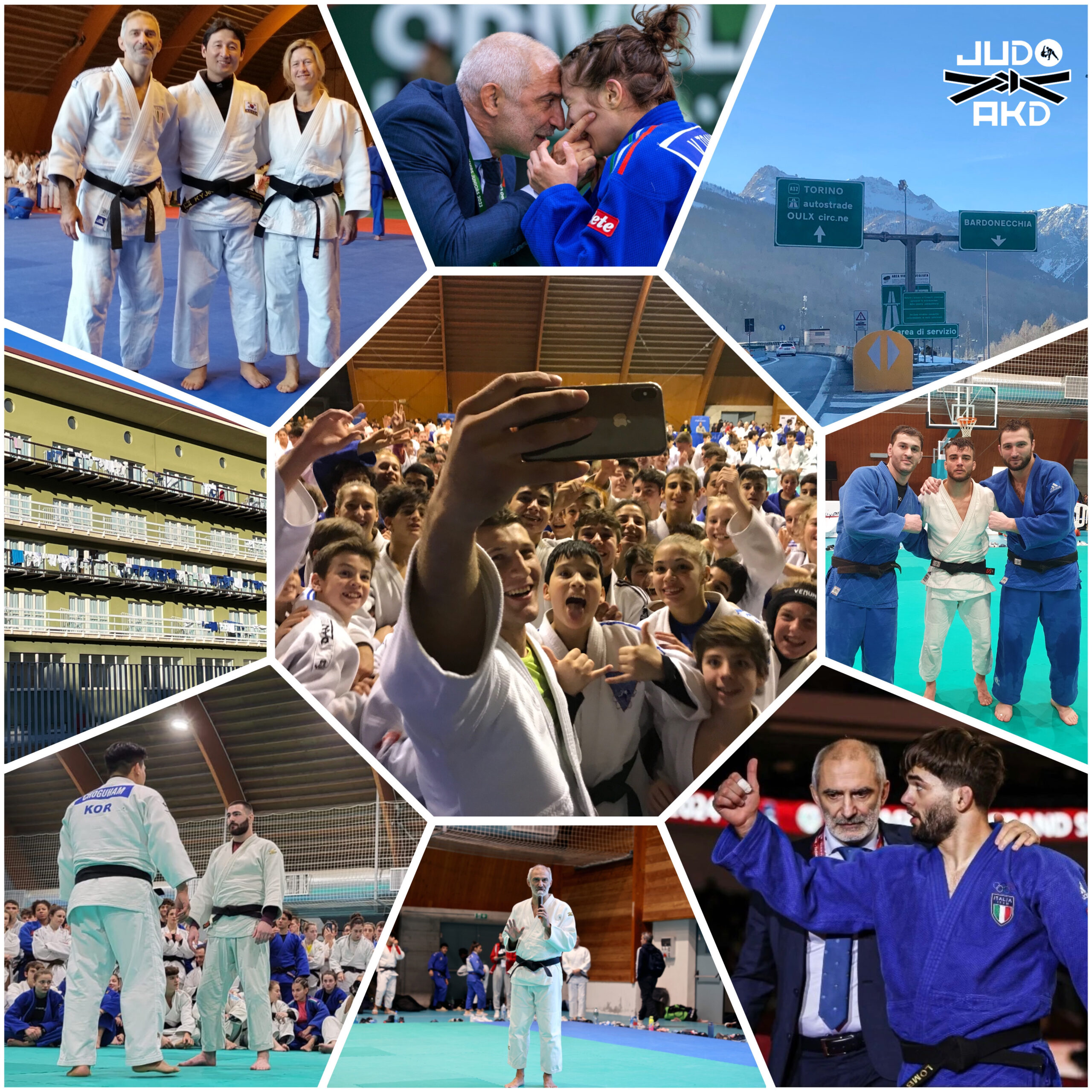
I’m not sure, but at the last Olympics, in judo, it seems that you were the only father sitting in his daughter’s coach’s chair. Veronica had a difficult draw with, as at the World championships two months before, a Japanese opponent for her first bout. What did you both take away from the experience?
I don’t think there were any other parents training their son or daughter at the Paris Olympics. I think Veronica will learn a lot from these Games, especially as forty days before the Games, she injured her left hand. On the day of the competition, her hand wouldn’t close at all, so for her to compete without being able to rely on it wasn’t ideal. Her draw was terrible, with Japan’s Funakubo at the start, but she got up on the mat to win. For me, that was the best she could do given her physical condition.
She also seemed very disappointed by the final bout of the mixed team event, against Brazil’s Silva. What do you think she will take away from this week?
In the team competition, Veronica once again fought with a very good attitude, although the shock of defeat in the last decisive bout was heavy to bear. Immediately afterwards, the whole team came to see her and everyone had the right words. A few hours later, her teammates also spoke to her a lot. I think these discussions helped her a lot to overcome this difficult situation… As after every setback, Veronica is looking forward to training and getting back into competition as soon as possible but, for the moment, we’re trying to get a better understanding of the state of her left hand because, as we speak, the situation is almost the same as in Paris.
In Paris, Monica, Pierangelo and many others were in the stands… Is this family aspect a key factor in your athletes’ performances?
It certainly is. Our athletes have been training with us since they started out, so we know them very well, the judokas, their families and their personal situations. We spend a lot of time together, both at the Akiyama and around the world. We all have a very strong bond.
How would you sum up the last Olympiad?
Over the last three years, the Akiyama has tried to qualify more than three judokas for the Olympics, in order to beat our Tokyo record. In the end, we qualified four, including, for the first time, a woman. At the Games, Veronica and our U60kg Andrea Carlino had a very bad draw and, un the U66 kg weight category, Matteo Piras lost because of a decision that, even today, I still don’t understand. Manuel Lombardo is a different story. I think he was very contracte throughout the competition and wasn’t able to show his value… In any case, this Olympiad has seen our athletes win medals in the senior and junior World championships, the Grand Slam, the Grand Prix, the Europe U23 and the European junior championships… Many of them are very young and will be going all the way to Los Angeles at least. As for our athletes, despite the lack of medals in Paris, I think this Olympic period has been very good.
What about the national team, of which you are one of the coaches?
The Tokyo Games produced results that our federation had never achieved before. Since then, for the first time in just three years rather than four, we have won gold medals in all types of championships: European and World cadet championships, European and World junior championships, European U23 championships, European and World senior championships and the Olympic Games. We qualified thirteen judokas for the Olympic Games. Our previous record was nine.
What are the federal objectives for the new Olympic cycle?
We want to improve the decentralization of training, which has been one of the keys to the success of this Olympic cycle.
And what do you think of the refereeing reforms that most people in the game would like to see?
In my opinion, we should go back to awarding waza ari as in the old days and, for everything else, it’s preferable to award yuko. Similarly, for certain penalties, it is preferable to change: the unconventional seizure must be sanctioned within a maximum of three seconds if Tori does not attack; in seniors only, it is preferable to cancel the sanction for ‘head first’. Finally, if a false attack is to be punished, we need to find a way of distinguishing it from a weak attack.
Which nations do you think will be the most interesting to follow or coach in the next Olympic cycle?
I think that before the Los Angeles Games, many nations will be interesting to watch. I’m thinking of Uzbekistan and Georgia who, in the past, have achieved very good results in the men’s event, but who are also working harder and harder in the women’s event. And when I say ‘working’, I mean working on internal women’s judo, not ‘buying’ judokas from other nations. Turkmenistan and Tajikistan will certainly increase their results too. And don’t forget the United States, who I’m sure will invest a lot of money in developing their judokas on the road to the home Olympics.
At Bardonecchia, the after-dinner drinks are often an opportunity to spend some very special moments with the champions. It gives us a better understanding of how the world of judo is evolving. What do you take away from all these conversations? Perhaps, for example, it helped you to understand quite early on that the system of big nations (Japan, France, Russia…) was about to decline and that the ‘small’ nations were in the process of developing…
Interesting question. At each edition of the Bardonecchia camp, I have the opportunity to spend a few days, before or after the camp, with one or more of the great champions. I remember many moments on the tatami or during the third half. I remember conversations about the development of judokas from cadets to seniors with the German Richard Trautmann at Bar Sport during the first editions at Gressoney. I also shared many amusing moments with Lipo and Avto [Georgians Varlam Liparteliani and Avtandili Tchrikishvili, ed. note] during the camp and also during our visit to Milan; I talk with Canadian Christa Deguchi about Italian cuisine and how to do it better; I have a lovely moment during our visit to Venice with Korean legend Mister Jeon and I could go on for hours…
Is there a common denominator between all these people and all these moments?
All the great champions who come to Bardonecchia are, first and foremost, great men and women. I’ve known some of them since they were children – I’m thinking of the two Slovenian Olympic champions Urska Zolnir and Tina Trstenjak – or because I’ve met them as coaches around the world, or simply because they’re athletes who compete against my athletes. In any case, they all approach the camp with an exemplary attitude to show each of the participants their way of doing judo.
Especially after the sessions, I have the opportunity to discuss a lot of things and thanks to their explanations, I can learn a lot about judo in their country or about the preparation system for top-level athletes. For me, every year is the best opportunity to learn not only on the mat, but also off it. It’s holidays for sure, but it’s an extraordinary school.
This year 2024 you’ll have Christa Deguchi for the second time and another Canadian from Japan, Kyle Reyes, who just turn third at the Tokyo Grand Slam in the U100 kg weight class category. If the champions come back and even bring back a compatriot the next time, maybe it’s because the first experience was a good one…
The champions like to stay and come back to Bardonecchia, both for the atmosphere and for the people who love them. Germany’s Ole Bishof came for the first time in 2010 after winning the 2008 Olympic title. I was joking with him and said: ‘When you win another Olympic medal, you have to come back here’. I called him after the London final and he came back to Bardonecchia in 2013… Same thing for Christa: after her first Bardonecchia in 2022, I told her that she could come back after winning the Olympics and that the tradition would continue. And that’s exactly what she’s doing this year!
As for former European champion Tommy Macias, will he be the first to come from Sweden?
Yes, Tommy will be the first Swede. I’ve known him since he was a junior and competed against my judokas, then later as a senior when he fought against Fabio Basile. We’ve worked with him at the Akiyama for some time and our team is confident that he’ll be ‘the right man at the right place’ this year in Bardonecchia.
What makes you prouder: seeing one of your daughters on the mat at the Olympic Games or putting so many children and adults in contact with great champions and other nationalities over the years?
These are two completely different sensations. Seeing my daughter compete in Paris was one of the most exciting moments of my life, and having my wife Monica and my eldest daughter Elisa with us completes the circle. On the other hand, seeing a thousand people every year sharing the same mat as great champions and watching them grow from year to year is also very exciting. And it’s been going on since 1996!
If the Raffaele of 2024 could give advice to the Raffaele who got his first white belt almost fifty years ago now, what would he say to him?
If I had the opportunity to give young Raffaele some advice, I’d say to him: ‘Stay strong in your goals, talk to everyone, learn from everyone and believe in your work because, in the end, life will pay you back a hundredfold’. – Interview by Anthony Diao, Spring-Autumn 2024. Photo editing: Thomas Eustratiou-Diao. Opening picture: Gabriela Sabau/IJF via JudoInside.
A French version of this interview is available here.
More articles in English:
- JudoAKD#001 – Loïc Pietri – Pardon His French
- JudoAKD#002 – Emmanuelle Payet – This Island Within Herself
- JudoAKD#003 – Laure-Cathy Valente – Lyon, Third Generation
- JudoAKD#004 – Back to Celje
- JudoAKD#005 – Kevin Cao – Where Silences Have the Floor
- JudoAKD#006 – Frédéric Lecanu – Voice on Way
- JudoAKD#008 – Annett Böhm – Life is Lives
- JudoAKD#009 – Abderahmane Diao – Infinity of Destinies
- JudoAKD#010 – Paco Lozano – Eye of the Fighters
- JudoAKD#011 – Hans Van Essen – Mister JudoInside
- JudoAKD#021 – Benjamin Axus – Still Standing
- JudoAKD#022 – Romain Valadier-Picard – The Fire Next Time
- JudoAKD#023 – Andreea Chitu – She Remembers
- JudoAKD#024 – Malin Wilson – Come. See. Conquer.
- JudoAKD#025 – Antoine Valois-Fortier – The Constant Gardener
- JudoAKD#026 – Amandine Buchard – Status and Liberty
- JudoAKD#027 – Norbert Littkopf (1944-2024), by Annett Boehm
- JudoAKD#029 – Riner, Krpalek, Tasoev – More than Three Men
- JudoAKD#030 – Christa Deguchi and Kyle Reyes – A Thin Red and White Line
- JudoAKD#031 – Jimmy Pedro – United State of Mind
- JudoAKD#032 – Christophe Massina – Twenty Years Later
- JudoAKD#033 – Teddy Riner/Valentin Houinato – Two Dojos, Two Moods
- JudoAKD#034 – Anne-Fatoumata M’Baïro – Of Time and a Lifetime
- JudoAKD#035 – Nigel Donohue – « Your Time is Your Greatest Asset »
- JudoAKD#036 – Ahcène Goudjil – In the Beginning was Teaching
- JudoAKD#037 – Toma Nikiforov – The Kalashnikiforov Years
- JudoAKD#038 – Catherine Beauchemin-Pinard – The Rank of Big Sister
- JudoAKD#039 – Vitalie Gligor – « The Road Takes the One Who Walks »
- JudoAKD#040 – Joan-Benjamin Gaba and Inal Tasoev – Mindset Matters
- JudoAKD#041 – Pierre Neyra – About a Corner of France and Judo as It Is Taught There
- JudoAKD#042 – Theódoros Tselídis – Between Greater Caucasus and Aegean Sea
More Replays in English:
- JudoAKDReplay#001 – Pawel Nastula – The Leftover (2017)
- JudoAKDReplay#002 – Gévrise Emane – Turn Lead into Bronze (2020)
- JudoAKDReplay#003 – Lukas Krpalek – The Best Years of a Life (2019)
- JudoAKDReplay#004 – How Did Ezio Become Gamba? (2015)
- JudoAKDReplay#005 – What’s up… Dimitri Dragin? (2016)
- JudoAKDReplay#006 – Travis Stevens – « People forget about medals, only fighters remain » (2016)
- JudoAKDReplay#007 – Sit and Talk with Tina Trstenjak and Clarisse Agbégnénou (2017)
- JudoAKDReplay#008 – A Summer with Marti Malloy (2014)
- JudoAKDReplay#009 – Hasta Luego María Celia Laborde (2015)
And also :
JudoAKD – Instagram – X (Twitter).


